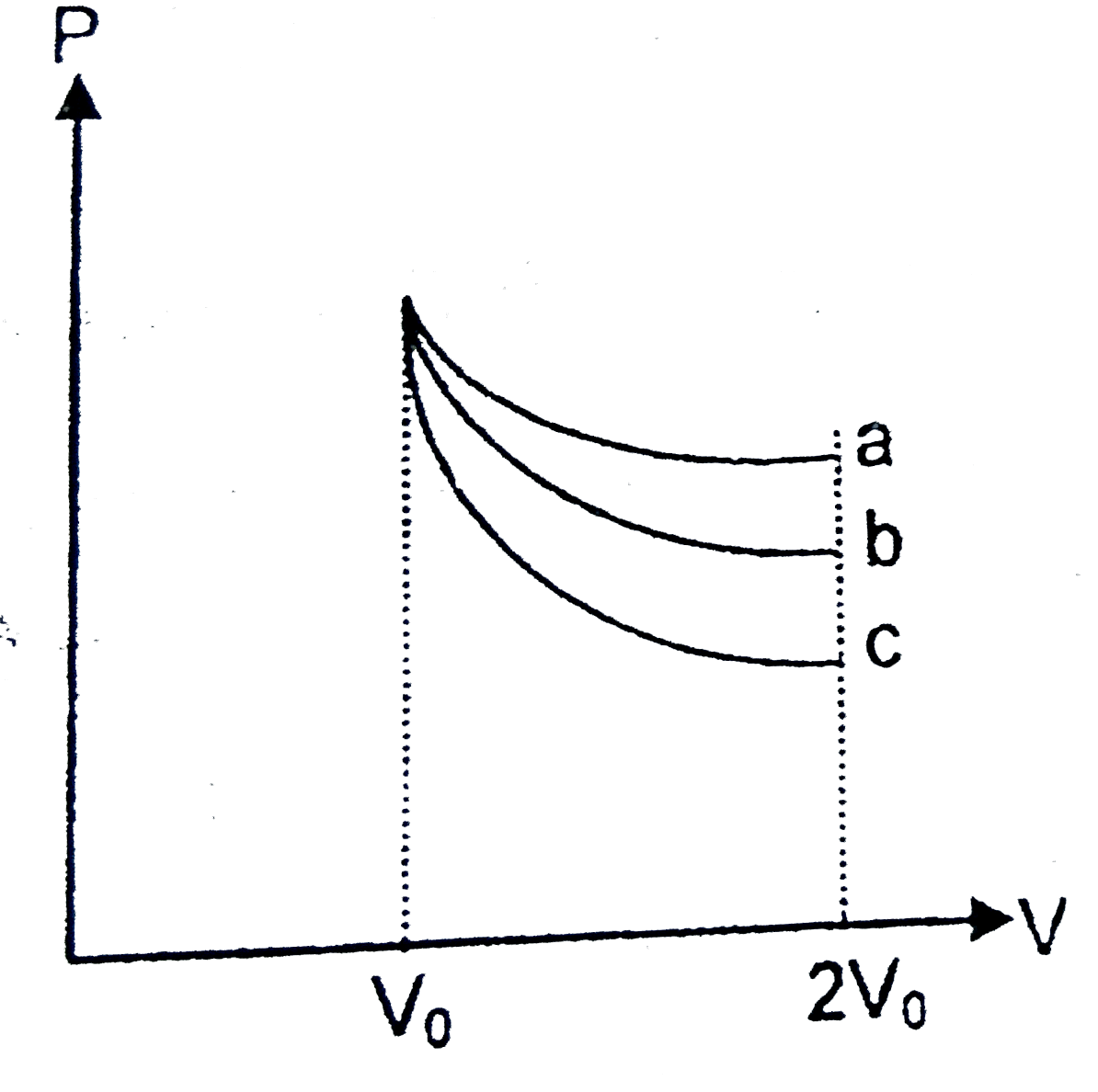The internal energy of a gas is given by U=5+2PV. It expands from V0 to 2V0 against a constant pressure P0. The heat absorbed by the gas in the process is :-
−3P0V0
3P0V0
2P0V0
P0V0
The correct Answer is:B
To solve the problem, we will follow these steps:
Step 1: Determine the Work Done (W)
The work done by the gas during expansion against a constant pressure is given by the formula:
W=PΔV
where ΔV=Vf−Vi. In this case, the initial volume Vi=V0 and the final volume Vf=2V0. Therefore:
ΔV=2V0−V0=V0
Substituting this into the work formula with P=P0:
W=P0⋅V0
Step 2: Calculate the Change in Internal Energy (ΔU)
The change in internal energy is given by:
ΔU=Uf−Ui
We know that the internal energy U is given by:
U=5+2PV
Now, we will calculate Uf and Ui:
- For the final state (at volume Vf=2V0):
Uf=5+2P0(2V0)=5+4P0V0
- For the initial state (at volume Vi=V0):
Ui=5+2P0(V0)=5+2P0V0
Now, substituting these into the change in internal energy:
ΔU=(5+4P0V0)−(5+2P0V0)=4P0V0−2P0V0=2P0V0
Step 3: Apply the First Law of Thermodynamics
According to the first law of thermodynamics:
Q=ΔU+W
Substituting the values we found for ΔU and W:
Q=2P0V0+P0V0=3P0V0
Final Answer
Thus, the heat absorbed by the gas in the process is:
3P0V0
The work done by the gas during expansion against a constant pressure is given by the formula:
W=PΔV
where ΔV=Vf−Vi. In this case, the initial volume Vi=V0 and the final volume Vf=2V0. Therefore:
ΔV=2V0−V0=V0
Substituting this into the work formula with P=P0:
W=P0⋅V0
The change in internal energy is given by:
ΔU=Uf−Ui
We know that the internal energy U is given by:
U=5+2PV
Now, we will calculate Uf and Ui:
- For the final state (at volume Vf=2V0):
Uf=5+2P0(2V0)=5+4P0V0
- For the initial state (at volume Vi=V0):
Ui=5+2P0(V0)=5+2P0V0
Now, substituting these into the change in internal energy:
ΔU=(5+4P0V0)−(5+2P0V0)=4P0V0−2P0V0=2P0V0
According to the first law of thermodynamics:
Q=ΔU+W
Substituting the values we found for ΔU and W:
Q=2P0V0+P0V0=3P0V0
Thus, the heat absorbed by the gas in the process is:
3P0V0
Topper's Solved these Questions
- GEOMETRICAL OPTICSBOOK - ALLENCHAPTER - GEOMETRICAL OPTICSEXERCISE - EXERCISE -02
82 Videos
- GEOMETRICAL OPTICSBOOK - ALLENCHAPTER - GEOMETRICAL OPTICSEXERCISE - EXERCISE -03
10 Videos
- GEOMETRICAL OPTICSBOOK - ALLENCHAPTER - GEOMETRICAL OPTICSEXERCISE - SOME WORKED OUT EXAMPLES
83 Videos
- CURRENT ELECTRICITYBOOK - ALLENCHAPTER - CURRENT ELECTRICITYEXERCISE - EX.II
66 Videos
- GRAVITATIONBOOK - ALLENCHAPTER - GRAVITATIONEXERCISE - EXERCISE 4
9 Videos
Similar Questions
The internal energy of a gas is given by U = 3 pV. It expands from V0 to 2V0 against a constant pressure p0.
The heat absorbed by the gas in the process is
View SolutionThe internal energy of a gas is given by U=2pV. It expands from V0 to 2V0 against a constant pressure p0. The heat absorbed by the gas in the process is
View SolutionThe internal energy of a gas is given by U=2pV. It expands from V0 to 2V0 against a constant pressure p0. The heat absorbed by the gas in the process is
View SolutionThe internal energy of a gas is given by U = 3 pV. It expands from V0 to 2V0 against a constant pressure p0.
What is the value of γ(=CP/CV) for the given gas?
View SolutionThe internal energy of a gas is given by U=1.5pV. It expands from 100cm3→200cm3 against a constant pressure of 1.0×105 Pa. calculate the heat absorbed by the gas in the process.
View SolutionThe internal energy of a gas is given by U=PV2. At constant volume, state of gas changes from (P0,V0) to (3P0,V0) then
View SolutionA diatomic gas with rigid molecules does 10J of work when expanded at constant pressure. The heat energy absorbed by the gas, in this process is ___________ (in J).
View SolutionA diatomic gas with rigid molecules does 10J of work when expanded at constant pressure. The heat energy absorbed by the gas, in this process is ___________ (in J).
View SolutionA gas expends from 2L to 6L against a constant pressure of 0.5 atm on absobing 200J of heat. Calculate the change in internal energy.
View SolutionAn ideal gas may expands from V0 to 2V0 according to following three processes. Molar specific heat for processes b will be

View Solution
